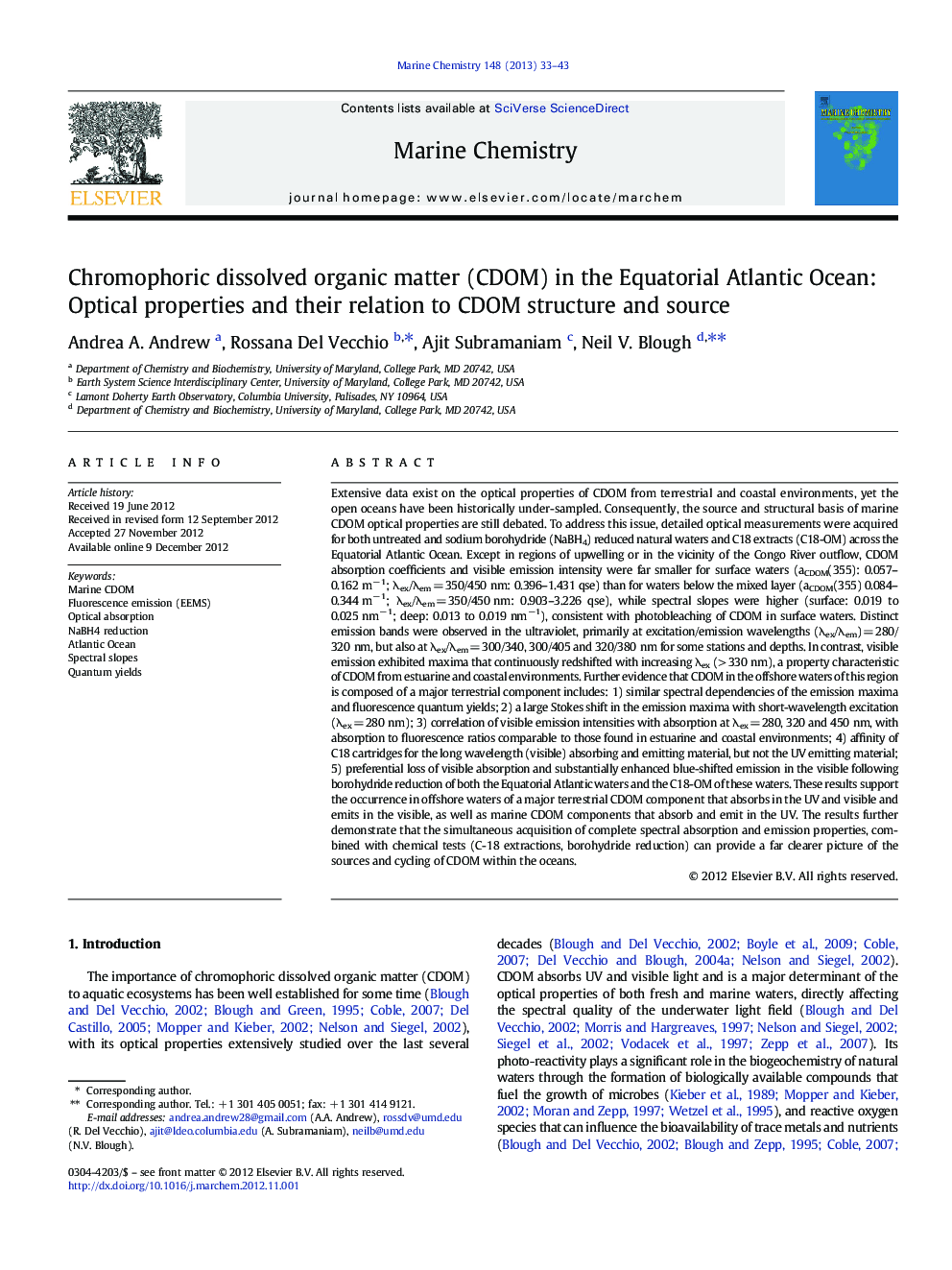| کد مقاله | کد نشریه | سال انتشار | مقاله انگلیسی | نسخه تمام متن |
|---|---|---|---|---|
| 1261620 | 1496687 | 2013 | 11 صفحه PDF | دانلود رایگان |

Extensive data exist on the optical properties of CDOM from terrestrial and coastal environments, yet the open oceans have been historically under-sampled. Consequently, the source and structural basis of marine CDOM optical properties are still debated. To address this issue, detailed optical measurements were acquired for both untreated and sodium borohydride (NaBH4) reduced natural waters and C18 extracts (C18-OM) across the Equatorial Atlantic Ocean. Except in regions of upwelling or in the vicinity of the Congo River outflow, CDOM absorption coefficients and visible emission intensity were far smaller for surface waters (aCDOM(355): 0.057–0.162 m− 1; λex/λem = 350/450 nm: 0.396–1.431 qse) than for waters below the mixed layer (aCDOM(355) 0.084–0.344 m− 1; λex/λem = 350/450 nm: 0.903–3.226 qse), while spectral slopes were higher (surface: 0.019 to 0.025 nm− 1; deep: 0.013 to 0.019 nm− 1), consistent with photobleaching of CDOM in surface waters. Distinct emission bands were observed in the ultraviolet, primarily at excitation/emission wavelengths (λex/λem) = 280/320 nm, but also at λex/λem = 300/340, 300/405 and 320/380 nm for some stations and depths. In contrast, visible emission exhibited maxima that continuously redshifted with increasing λex (> 330 nm), a property characteristic of CDOM from estuarine and coastal environments. Further evidence that CDOM in the offshore waters of this region is composed of a major terrestrial component includes: 1) similar spectral dependencies of the emission maxima and fluorescence quantum yields; 2) a large Stokes shift in the emission maxima with short-wavelength excitation (λex = 280 nm); 3) correlation of visible emission intensities with absorption at λex = 280, 320 and 450 nm, with absorption to fluorescence ratios comparable to those found in estuarine and coastal environments; 4) affinity of C18 cartridges for the long wavelength (visible) absorbing and emitting material, but not the UV emitting material; 5) preferential loss of visible absorption and substantially enhanced blue-shifted emission in the visible following borohydride reduction of both the Equatorial Atlantic waters and the C18-OM of these waters. These results support the occurrence in offshore waters of a major terrestrial CDOM component that absorbs in the UV and visible and emits in the visible, as well as marine CDOM components that absorb and emit in the UV. The results further demonstrate that the simultaneous acquisition of complete spectral absorption and emission properties, combined with chemical tests (C-18 extractions, borohydride reduction) can provide a far clearer picture of the sources and cycling of CDOM within the oceans.
► Complete optical properties of CDOM and C18-OM were acquired across the Equatorial AO.
► C18 extraction and NaBH4 reduction impact on oceanic CDOM optical properties was probed.
► Region exhibits properties similar to those of other terrestrial/coastal regions.
► Data provides evidence of a major terrestrial CDOM component at this locale.
Journal: Marine Chemistry - Volume 148, 20 January 2013, Pages 33–43